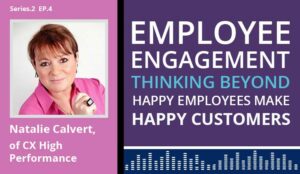Nina Mansell introduces a strategy which aims to help contact centres boost employee engagement, without harming service levels.
Having worked with contact centre professionals over the last 15 years, I have seen first-hand the pressures faced by operational teams to achieve service levels and ensure customers remain loyal and happy.
With all good intentions and often under the pressures to meet service levels, organisations can lose sight of the importance of keeping employees engaged with the organisation, often resulting in attrition.
Defining Employee Engagement
According to the “2017 Trends in Global Employee Engagement” report by Aon, engagement is defined as employees:
- Saying positive things about the organisation and acting as advocates
- Intending to stay at their organisation for a long time
- Being motivated to strive to give their best efforts to help the organisation succeed
One way to meet each of these criteria is through a focus on coaching. But how can contact centres make time for coaching, without it influencing service levels?
Coaching
Coaching and 1-2-1s are a fantastic opportunity to engage employees. But, having led in-house learning and development functions and consulted with other businesses, it is often coaching and 1-2-1 time that is cut to meet service levels.
So a key aim of this article is to assist organisations to use limited allocated offline time to drive motivation, develop skills, and encourage employee development and retention – while remaining within service levels to meet the needs of the customers.
Line managers in modern contact centres have much data available and are able to see at a glance where employees need to improve. They should be able to group people into categories for development without having to do lots of pre-call listening just by seeing the stats and knowing how their team interact on a daily basis.
Areas of Underperformance
Typical underperformance areas within contact centre environments tend to be:
- Average Handling Time (AHT) too high
- Quality scores / Customer satisfaction (CSat) scores below target
- After Call Work (ACW) / Wrap time too high
- Motivation / Will Issues
- Product Knowledge
Each of these areas of underperformance can damage employee engagement, but they can be lessened by effective coaching.
If the line manager spent five hours developing five group coaching sessions/bite-size knowledge sessions that take 20 minutes to deliver, each advisor would only be required to be offline for 20 minutes at a time.
A 2015 CIPD Learning and Development Survey found that on-the-job training, in-house development programmes and coaching by line managers, or peers, remain the most commonly used and the most effective development methods.
For a total investment of just seven hours of line manager time over a month, every employee on the team will have had a coaching intervention and have only been offline for 20 mins!
It’s also worth noting that as the manager develops these sessions, they are available to be used again, shared amongst other managers and continually built upon. It is likely that in just three months, a single department will have built a library of development sessions to fit the needs and development stages of the team!
Learning and Development
If you have an L&D (Learning and Development) function, it may also be able to partner you in developing these sessions and perhaps develop them into interactive gamification or e-leaning modules, allowing for a more blended approach. Once again, these should remain bite-size and should only take an employee 20 minutes to complete.
If you do not have the luxury of an L&D function, a sharing platform amongst line managers can lighten the load in terms developing the sessions!
Don’t forget your high performers too. Line managers should still aim to keep these people engaged, even if they are meeting all their targets. Put together some development sessions to help grow the skill set of these employees in terms of their career development. If you have an internal career path and/or leadership competencies, the development sessions should link to the skills and behaviours outlined in these frameworks.
If there is no career path or leadership competencies in your organisation, develop sessions on areas that are likely to drive business results and the individual’s progress, e.g. problem solving, coaching, leadership, interview skills, CV writing tips and so on.
Next, it’s about embedding the knowledge they took from their 20-minute knowledge session. My suggestion is that after each group coaching session, every employee is given a challenge/mission whereby they have to provide their manager with evidence over the next two weeks where they have implemented the knowledge from their coaching session (likely to be examples of calls).
How much offline does this take from a call taking/making employee? Nothing, because they are already taking/making these calls. With this kind of exercise, you are creating employees who take responsibility, accountability and ownership for their own development and lessening the pressure on line managers!
If the line manager can listen to just two calls from each employee, with an average call lasting five minutes in a large team of 15, this has taken approximately two and a half hours of their time over a month.
Follow-Up
Follow-up is the final and critical stage. If the line manager spends just ten minutes with each employee, feeding back on the random spot-check calls they have listened to from the employee’s evidence examples, this would take a further two hours and 30 minutes of line manager time. Yet the employee would have been engaged once again outside of their original coaching session and will feel their contribution of feeding back the calls was worthwhile.
Allowing the line manager three hours administration time to document their coaching sessions and feedback to the team is crucial for auditing purposes.
For just 15 hours (3.75 hrs per week) of line manager time over a month and 30 mins per employee for the month, each employee has had a group coaching session, taken ownership for evidencing their learning and had a documented 1-2-1 feedback session.
By my calculation, if anyone has development areas outside of the group coaching sessions, there are still 15 minutes per employee left to play with in terms of offline time!
Conclusion

Nina Mansell
None of this is rocket science. It’s about getting smarter with what you have. Just 15 hours’ investment a month from a line manager who works an average 150 hours in a month is just 10% of their time spent developing the team, yet the impact is so much more.
In this 15 hours, line managers will be driving ownership for development amongst employees, developing a skilled workforce, motivating and engaging employees, meeting service levels and making customers happy! It’s a win–win!
Thanks to Nina Mansell, a Learning Partner at WDR Learning
For more from Domestic & General, read our article: 8 Quick Ideas From the Domestic & General Contact Centre
Author: Robyn Coppell
Published On: 23rd Apr 2018 - Last modified: 18th Aug 2025
Read more about - Call Centre Management, Employee Engagement, Management Strategies, Service Level, Training and Coaching






































